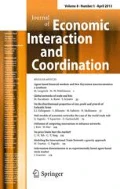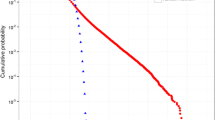Abstract
We show that an economic system populated by multiple agents generates an equilibrium distribution in the form of multiple scaling laws of conditional probability density functions, which are sufficient for characterizing the probability distribution. The existence of the double scaling law is demonstrated empirically for the sales and the labor of one million Japanese firms. Theoretical study of the scaling laws suggests lognormal joint distributions of sales and labor and a scaling law for labor productivity, both of which are confirmed empirically. This framework offers characterization of the equilibrium distribution with a small number of scaling indices, which determine macroscopic quantities, thus setting the stage for an equivalence with statistical physics, bridging micro- and macro-economics.





Similar content being viewed by others
References
Aoki M, Yoshikawa H (2007) Reconstructing macroeconomics: a perspective from statistical physics and combinatorial stochastic processes. Cambridge University Press, New York
Aoyama H, Yoshikawa H, Iyetomi H, Fujiwara Y (2009) Prog Theor Phys Suppl 179:80
Aoyama H, Fujiwara Y, Ikeda Y, Iyetomi H, Souma W (2010) Econophysics and companies: statistical life and death in complex business networks. Cambridge University Press, New York
Aoyama H, Yoshikawa H, Iyetomi H, Fujiwara Y (2010) J Econ Interact Coord 5(1):27
Blume L, Durlauf S (eds) (2006) Economy as an evolving complex system III, Current perspectives and future directions. Oxford University Press, Oxford
Delli Gatti D, Gaffeo E, Gallegati M, Giulioni G, Palestrini A (2008) Emergent macroeconomics: an agent-based approach to business fluctuations. Springer, Berlin
Foley K (1994) Duncan. J Econ Theory 62(2):321
Galí J (2008) Monetary policy, inflation, and the business cycle. Princeton University Press, New Jersey
Hayfield T, Racine JS (2008) J Stat Softw 27(5)
Ikeda Y, Souma W (2009) Prog Theor Phys Suppl 179:93
Keynes J (1936) The general theory. McMillan, London
Kydland F, Prescott E (1982) Econometrica. J Econ Soc 1345–1370
Li Q, Racine JS (2007) Nonparametric econometrics: theory and practice. Princeton University Press, New Jersey
Acknowledgments
We would like to thank H. Iyetomi, Y. Ikeda, W. Souma and H. Yoshikawa for discussions , support and encouragements. We also would like to thank the CRD Association for providing us with their database. The present work was supported in part by the Program for Promoting Methodological Innovation in Humanities and Social Sciences, and by Cross -Disciplinary Fusing of the Japan Society for the Promotion of Science, Grant-in-Aid for Scientific Research (B) 20330060 (2008-10), and Invitation Fellowship Program for Research in Japan (Short term) ID No.S-09132 of the Ministry of Education, Science, Sports and Culture, Japan.
Author information
Authors and Affiliations
Corresponding author
Appendix A: Proof of the consequences of the double scaling laws
Appendix A: Proof of the consequences of the double scaling laws
In this Appendix, we shall derive complete solutions of Eq. (10) and prove the consequences given in Sect. 3.
Let us first describe how Eq. (10) follows from the double scaling laws, (6) and (7). The joint probability (1) reads
In the following, we do not need to assume that this law is valid in all of the \((Y,L)\) space, but we only need to assume that this law is valid only in a region containing the reference point, \((Y_0,L_0)\).
Let us express the marginal PDFs, \(P_Y\) and \(P_L\), by the invariant functions, \(\varPhi _Y\) and \(\varPhi _L\). By substituting \(Y=Y_0\), \(L=L_0\) into Eq. (29), we have
respectively. Also, by substituting \((Y,L)=(Y_0,L_0)\) into Eq. (29), we have
Eq. (8) follows from Eqs. (30) and (32). Similarly, Eq. (9) follows from Eqs. (31) and (32). Thus we have expressed the marginal PDFs in terms of the invariant functions. Then, by substituting Eqs. (8) and (9) into Eq. (29) and by using the identity (32), we can arrive at Eq. (10). The equation (10) yields interesting consequences for the functions of \(\varPhi _Y(Y)\) and \(\varPhi _L(L)\), which we shall prove in what follows.
Let us define
Then Eq. (10) can be rewritten as
Let us expand Equation (35) with respect to \(y\) around \(y=0\). At \(O(y^0)\), it is satisfied trivially. At the next order, \(O(y^1)\), we have
where we note that the prime means the derivative with respect to the variable of that function, i.e.,
Therefore, \(\phi '_y(-\alpha \ell )=-(1/\alpha )(d/d\ell ) \phi _y(-\alpha \ell )\). As a result, we obtain the following differential equation for \(\phi _\ell (\ell )\):
whose general solution is,
where \(c\) is an arbitrary constant. By substituting \(\ell =0\) in the above, we fix \(c\):
By substituting Equation (39) to Equation (35), we obtain the following equation for \(\phi _y\):
Before proceeding to \(O(y^2)\), we note that this equation is satisfied by an arbitrary function \(\phi _y(y)\) for \(\alpha \beta =1\). Therefore, we study cases \(\alpha \beta =1\) and \(\alpha \beta \ne 1\) separately in the following.
Case: \(\varvec{\alpha \beta =1}\)
In this case, Equations (39) leads to,
where we denoted \(a:=\alpha \phi _y'(0)+\phi _\ell '(0)\). In terms of \(\varPhi \)s, we can see that this equation is equivalent to Eq. (11) by using (40). Then, substituting (11) into (8) and (9), we obtain the following:
We can express these equations as Eqs. (12) and (13), where the exponents are mutually related as shown in Eq. (14). These were what to be proved for this case.
Case: \(\varvec{\alpha \beta \ne 1}\)
In this case, the expansion of Equation (41) to the next order, \(O(y^2)\), leads to following:
which shows that \(\phi _y(y)\) is a quadratic function of \(y\).
Let us parametrize the general solution \(\phi _y(y)\) as follows;
By substituting this into Equation (39) and using Equation (40), we obtain the following:
In other words, the coefficient of the linear and the constant terms are not constrained by \(\phi _y(y)\).
By denoting \(\phi '_\ell (0)=s\) and \(\phi _\ell (0)=t\), and by substituting (46) and (47) back into the original expressions, we can prove what to be shown, namely Eqs. (16), (17), (18) and (19). These were what to be proved for this case.
Rights and permissions
About this article
Cite this article
Aoyama, H., Fujiwara, Y. & Gallegati, M. Micro-macro relation of production: double scaling law for statistical physics of economy. J Econ Interact Coord 10, 67–78 (2015). https://doi.org/10.1007/s11403-014-0124-6
Received:
Accepted:
Published:
Issue Date:
DOI: https://doi.org/10.1007/s11403-014-0124-6




